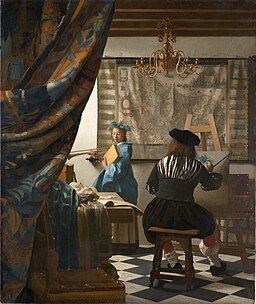
Woman Holding a Balance, 1664
Johannes Vermeer was baptised on October 31, 1632—the exact date is not known. A master of indoor scenes with cool daylight, Vermeer worked slowly and deliberately, with particular attention to objects, details, body language, symbolism and composition. His exact technique is something of debate amoung scholars, with theories floating around about everything from camera obscura devices to complex glazing techniques, yet one thing is certain: no drawings of his survive. It brings attention to how he was able to conceive of such elaborate compositions without the slightest preparatory sketch or drawing, and even looking at his work up close he often blurs details and smooths out brushstrokes, as if trying to mimic a camera. At any rate his understanding of light and how it falls on an object or person, inspired by the studies of Da Vinci, reveal a simple yet very complex observational skills and technique.
In Woman Holding a Balance Vermeer's delicate rendering of light and of women reveal a humble grace in this corner-room perspective that would dominate most of his paintings. A curious thing about Vermeer is that his figures are not outlined in any sort of line, and if they were blocked in this way he must have went through great pains to remove any trace of line. All his edges have been blended and softened, only showing any kind of sharpness if the light is catching it. His brush seems to even glide over any trace of anatomical structure, as the hands in this painting are quite simplistic up close yet appear accurate from a distance. Vermeer may have also experimented with different brushes to achieve his soft edges.
Read more about his technique here
And check out this four-part video series narrated by Meryl Streep

Officer and Laughing Girl, 1657
A surprisingly modern composition, this painting always strikes me this way every time I see it. An oddity of this painting is that the young girl is looking off into space to the left of the officer instead of directly into his eyes. The way that he sits with his back partially to us is curious and interesting compared to how small she appears to us, as if distorted by a camera lens. The strong use of red seems to suggest his intentions with her are anything but innocent, (especially in that he is hidden in shadow) and her smile may be a sign of cheerful acquiescence.

The Art of Painting,1668
Another strikingly modern painting, portrays the act of painting as a stage, a performance with the painter just as much the actor as the main subject. All is carefully arranged and nothing is quite as real as it seems. Vermeer's shadows are incredibly transparent and again, those edges are smoothened to the point of nonexistence. Here also the vibrant texture of the drapery framing the left side of the painting is captivating from afar yet up close we see a strange pattern of highlights and fuzzy shapes. The tiles on the floor are amazing to see up close, for we see somewhat harder edges on the black tiles with faint glowing warm white texture on the white tiles. Vermeer may have been the very first Post-Modern artist.

Girl Reading a Letter by an Open Window, 1659
A more poignant piece that is atypical of his work, this young woman is bathed in a warm morning light, with a bowl of fruit spilling over on the bed. The use of complementary colors in the vertical drapery is effective in framing her, along with the warm blue window frame with a brilliant soft shadow on the wall. Note her distorted reflection in the glass. The teeming glow of light on the wall behind her is an effect that would be reproduced by Turner over a century later. Vermeer creates a quiet mood here as in all of his paintings, yet he is always reminding us that it is only a painting.

The Milkmaid, ca.1660
My favourite of Vermeer's for many reasons, in particular his use of color and light, food, and the rendering of the figure is his most realistic. The way the corner of the room changes from very cool greens to a dull chalky hue is brilliant. And there is no flamboyant drapery anywhere here. Just the truth. Vermeer's truth.
Comments
Post a Comment